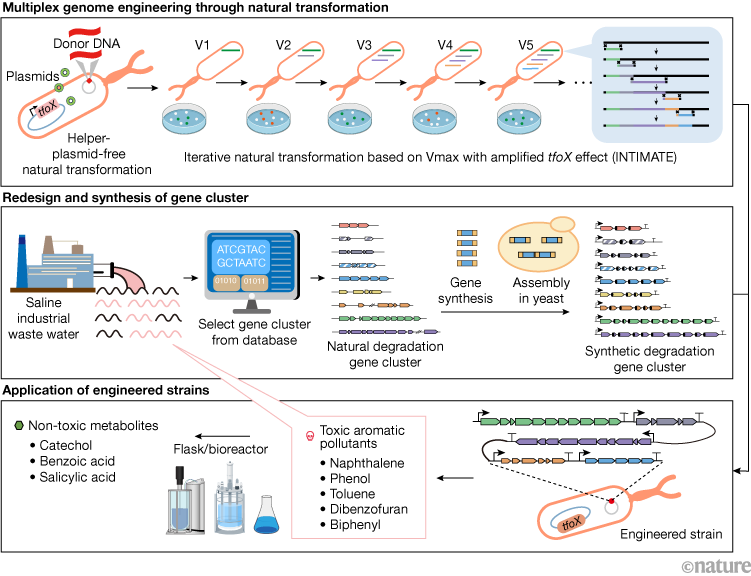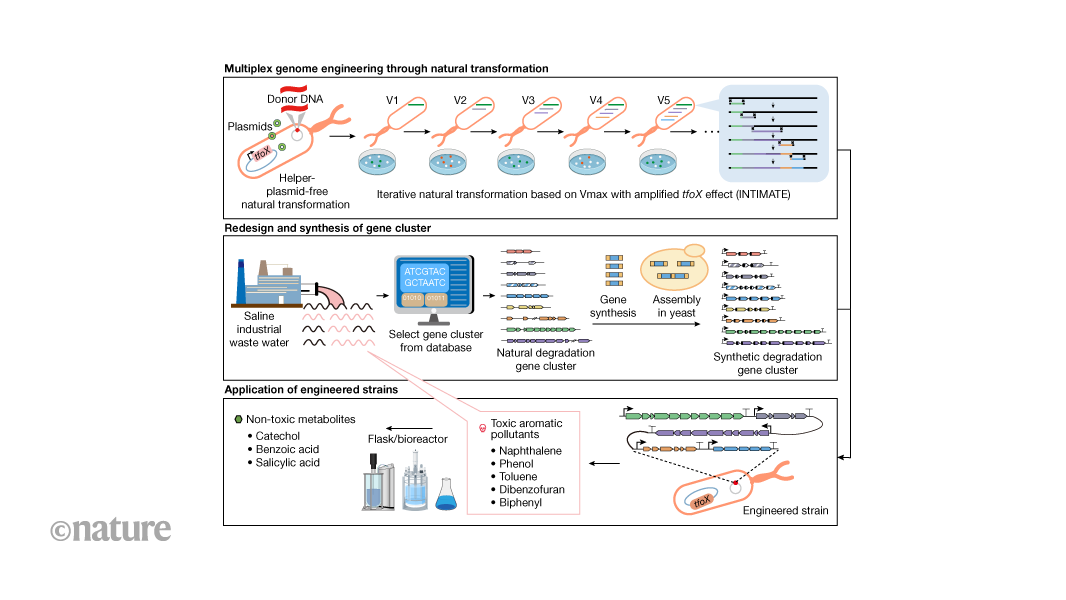This is a summary of: Su, C. et al. Bioremediation of complex organic pollutants by engineered Vibrio natriegens. Nature https://doi.org/10.1038/s41586-025-08947-7 (2025).
The problem
Organic pollutants pose considerable environmental risks owing to their toxicity, persistence and potential for long-range atmospheric transport1. Many such pollutants can be degraded or transformed into other compounds by some microorganisms2. However, contaminated environments, such as industrial waste water and oil-polluted marine sites, often contain complex mixtures of organic pollutants. Naturally occurring bacterial strains can typically degrade only one compound or a few that are structurally related. Furthermore, these strains are often sensitive to high salinity, limiting their effectiveness in remediating such sites.
The solution
A bacterial strain called Pseudomonas aeruginosa HS9 has a cluster of genes that enable it to degrade organic pollutants called HBCDs. We previously expressed these genes in a rapidly dividing bacterium, Vibrio natriegens Vmax, to engineer a pollutant-degrading Vmax strain3.
In the present study, we aimed to develop a bacterial strain that can degrade not just one but multiple pollutants, by integrating several gene clusters that each enable the degradation of a specific compound (Fig. 1). To improve the efficiency of this genome engineering, we inserted tfoX — a gene encoding a transcription-factor protein that enables the take-up of long DNA fragments — into chromosome 1 of V. natriegens. This enabled us to develop an approach we called ‘iterative natural transformation based on Vmax with amplified tfoX effect’ (INTIMATE) to ease the insertion and expression of long gene fragments. We then redesigned the gene clusters that enable seven bacterial strains to degrade aromatic compounds, inserted them into the V. natriegens genome and evaluated their functionality. Five of the redesigned gene clusters effectively enabled the degradation of compounds, and we sequentially integrated them into V. natriegens using INTIMATE. We tested the resulting strain, VCOD-15, for its ability to remediate mixtures of organic pollutants in saline media, industrial wastewater samples and saline soils.

Figure 1 | Schematic of the development of bacterial strain Vibrio natriegens VCOD-15, which can degrade five organic pollutants. VCOD-15 was engineered using a design–build–test–learn strategy. Redesigned gene clusters that each enable the degradation of a single pollutant were synthesized, assembled in yeast cells and inserted into the genome of V. natriegens bacteria. To increase the efficiency of introducing these clusters, the gene tfoX was integrated into the genome to enable the bacterial cell to take up long DNA fragments (that is, undergo ‘natural transformation’) without the need for loops of DNA called helper plasmids. Strains containing different numbers of degradation gene clusters were tested for their ability to convert the pollutants into non-toxic by-products. Ultimately, functional gene clusters were linked end-to-end and inserted into a single ‘chassis’ strain of V. natriegens, yielding VCOD-15. Images were created using BioRender (https://biorender.com).
After we inserted tfoX, the efficiency of integrating genome fragments into the V. natriegens genome increased from 1% to 78%. We used INTIMATE to insert five pollutant-degrading gene clusters, totalling 43,000 DNA base pairs, into chromosome 2 to generate the final engineered strain, VCOD-15. In saline flask cultures, VCOD‑15 removed 100.0% of biphenyl, 60.7% of phenol, 71.8% of naphthalene, 89.3% of dibenzofuran and 89.9% of toluene in 48 hours. Further experiments in bioreactors showed that VCOD-15 removed 90% of all five pollutants from industrial wastewater samples and considerably reduced the concentration of these complex organic pollutants in saline soil. Stable isotope tracing using 13C-labelled biphenyl and phenol, along with 2H-labelled naphthalene, dibenzofuran and toluene, confirmed the presence of molecular intermediates that would be expected to occur during degradation along the relevant metabolic pathways.
Future directions
The INTIMATE system provides a robust platform for engineering bacterial strains to metabolize a wide range of substrates. Marine pollutants such as azo dyes, organohalides and microplastics present increasing environmental challenges, so gene clusters that degrade them could be incorporated into VCOD-15 to enhance its remediation potential.
Despite this potential, however, VCOD-15 has some limitations. Notably, it cannot use pollutants as carbon or energy sources for growth, and therefore requires external carbon sources, such as yeast extract or corn steep liquor, during wastewater treatment. Furthermore, VCOD-15 exhibits less growth in low-salinity environments than do degraders, such as the bacterium Pseudomonas putida, that are native to such environments. This hinders the application of VCOD-15 in coastal marine areas, where freshwater inflows can cause the salinity to fluctuate4.
To ensure environmental safety, biocontainment systems or mechanisms to prevent the unintended spread of VCOD-15 or related strains in the ecosystem — such as genetic systems called inducible suicide loops that trigger cell death in a controlled way — could be integrated into engineered strains. Furthermore, biosensor-equipped DNA elements that differentially regulate gene expression depending on pollutant concentrations could enable controlled in situ degradation. Such strategies could enable the safe termination of microbial communities in the ecosystem once remediation is complete5. — Hongzhi Tang is at Shanghai Jiao Tong University, Shanghai, China, and Junbiao Dai is at the Agricultural Genomics Institute at Shenzhen, Chinese Academy of Agricultural Sciences, Shenzhen, China.
Behind the paper
The most exciting moment of this project came on 31 August 2022, when we first observed VCOD-15 simultaneously removing all five pollutants from a saline medium. Remarkably, VCOD-15 outperformed a synthetic consortium of five individual pollutant-remediating strains in treating a mixture of these compounds. However, proving its efficacy in real-world conditions — beyond controlled flasks and tubes — proved exceptionally challenging. We dedicated substantial effort to collecting wastewater samples and constructing experimental devices, including bioreactors and pot arrays, to evaluate the performance of VCOD-15 in wastewater and soil remediation. Over a period of 20 months, our team worked extended hours, often sacrificing weekends and holidays, to overcome these challenges and ultimately achieve this breakthrough. — H.T.
‘Expert opinion’ is published under a CC BY 4.0 licence.


